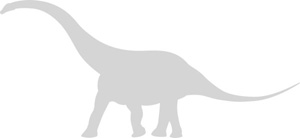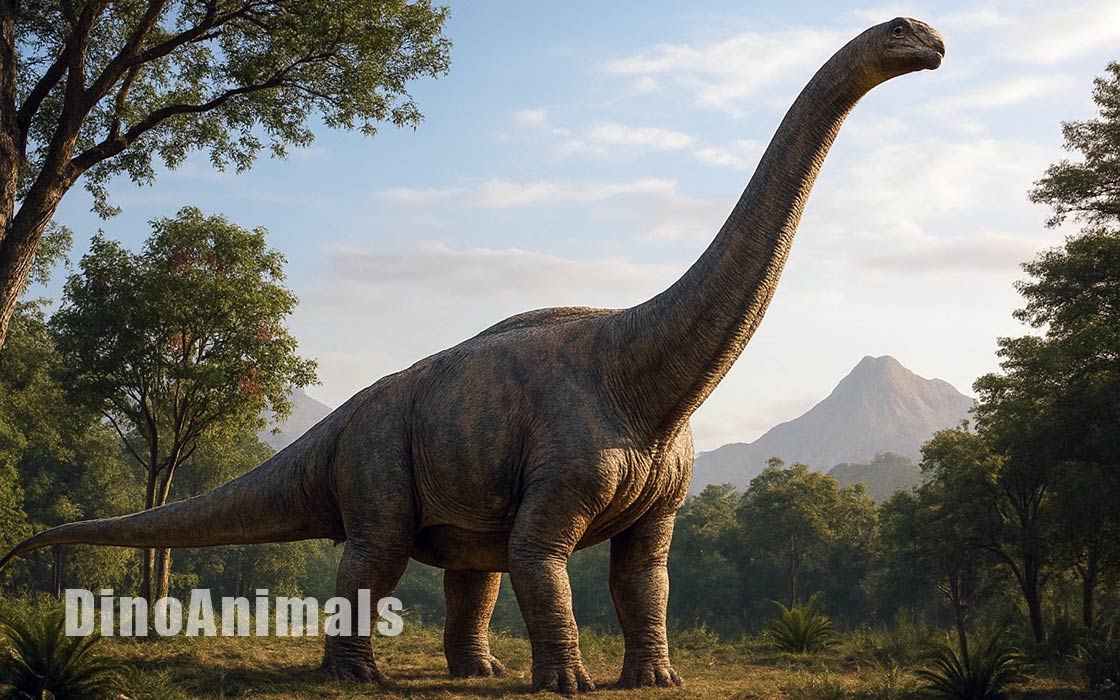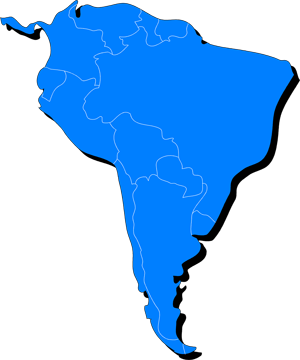Every month, 100,000 readers use the Dinosaur Database, but we receive no support from you. Developing and updating the database requires a lot of work. If you want it to remain open and be updated, please support us via the "Buy us a coffee" button available on every page or via the Support page.
Dinosaur: Puertasaurus reuili

| Length*: | 30 m | 98.4 ft |
| Weight*: | 70 t | 154,323 lb |
*The largest known specimen
Period
Epoch: Late Cretaceous
Stage: Campanian-Maastrichtian
Years: 76–70 Ma
Details
Status: valid
Author: Novas et al.
Year: 2005
Distribution
Area: South America
Country: Argentina
Region: Santa Cruz
Formation: Cerro Fortaleza
Description
Puertasaurus reuili
Puertasaurus reuili is a giant titanosaurian sauropod dinosaur from the Late Cretaceous period, approximately 76–70 million years ago. Discovered in the Río Leona Formation of Patagonia, Argentina, Puertasaurus is known for its massive size and unique skeletal features. It is considered one of the largest sauropods ever found. The genus name Puertasaurus honors Pablo Puerta, the fossil hunter who discovered the specimen, while the species name reuili recognizes Santiago Reuil, who assisted in the excavation.
Physical Characteristics
Puertasaurus reuili was an enormous sauropod, estimated to have reached lengths of up to 30 meters (~98 feet) or more, with a weight of up to 70 metric tons. The known remains include four vertebrae: a cervical (neck) vertebra, a dorsal (back) vertebra, and two caudal (tail) vertebrae. These bones are among the largest of any known sauropod, with the dorsal vertebra alone measuring about 1.06 meters (3.5 feet) in height.
The cervical vertebra was highly pneumatic (containing air sacs), an adaptation that lightened the bone while maintaining strength, which was essential for supporting the long neck of such a massive animal. The dorsal vertebra had large, deep pleurocoels (hollow depressions) that helped reduce weight and accommodated air sacs as part of the dinosaur’s respiratory system. The vertebrae’s structure indicates that Puertasaurus likely had a broad, barrel-shaped body supported by thick, column-like limbs typical of large titanosaurs.
Although only partial remains have been found, comparisons with other titanosaurs suggest that Puertasaurus had a long neck and tail, along with a relatively small head equipped with peg-like teeth, used for stripping vegetation from tall trees. Its body was likely robust, similar to other titanosaurs like Argentinosaurus and Patagotitan, and it had a long, flexible tail that helped with balance.
Diet and Feeding Habits
Puertasaurus reuili was a herbivore, feeding on a variety of plant materials, including conifers, ferns, and other Late Cretaceous vegetation. Its long neck allowed it to reach high into the forest canopy, giving it access to food sources that were out of reach for other herbivores. The peg-like teeth were adapted for stripping leaves off branches, and like other sauropods, Puertasaurus likely swallowed its food whole without much chewing.
Given its immense size, Puertasaurus would have needed to consume vast quantities of plant matter to sustain itself. It likely had a multi-chambered stomach and used fermentation to digest tough plant material, similar to modern herbivorous animals. The size and structure of its neck allowed Puertasaurus to cover a wide feeding area without moving its massive body frequently, making it an efficient forager.
Habitat and Distribution
Puertasaurus reuili lived in what is now the southern region of Patagonia, Argentina, during the Late Cretaceous. The Río Leona Formation, where its fossils were found, was part of a warm, humid environment that included river systems, floodplains, and forests. This region was home to a diverse array of plant life, including cycads, ferns, and coniferous trees, which would have provided ample food for a giant herbivore like Puertasaurus.
The area also supported other large dinosaurs, including smaller herbivores and theropods, which would have coexisted with Puertasaurus in the same ecosystem. The climate and environment of Patagonia during the Late Cretaceous were ideal for large sauropods, and Puertasaurus would have been one of the largest animals in this ecosystem.
Behavior and Social Structure
As with many other giant sauropods, Puertasaurus reuili likely lived in herds, moving across large areas in search of food and water. Living in groups would have provided protection for juveniles and allowed adults to maintain access to food resources. The sheer size of Puertasaurus would have deterred most predators, although juvenile individuals may have been vulnerable to attacks by large theropods.
Herding behavior has been inferred from trackways and fossil evidence for other sauropods, suggesting that they moved in groups across floodplains and forests. Puertasaurus likely exhibited similar behavior, with adults forming loose associations or herds while foraging. Its long neck would have allowed it to forage widely without needing to move frequently, conserving energy and making feeding more efficient.
Discovery and Research
The first fossils of Puertasaurus reuili were discovered in 2001 by fossil hunter Pablo Puerta in the Río Leona Formation of Patagonia, Argentina. The fossils were formally described in 2005 by Argentine paleontologist Fernando Novas. The holotype (MPM 10002) consists of four vertebrae: one cervical vertebra, one dorsal vertebra, and two caudal vertebrae. While these are the only known remains, they provide valuable insight into the size and structure of the animal.
Since its discovery, Puertasaurus has sparked considerable interest due to its immense size and unique vertebral anatomy. The large, pneumatic vertebrae and deep pleurocoels are particularly notable, as they indicate a highly specialized respiratory system and a lightened skeleton, adaptations crucial for supporting such a massive body. Ongoing research aims to uncover more complete fossils that could provide further information about this giant sauropod’s full anatomy and lifestyle.
Significance and Interesting Facts
Puertasaurus reuili is significant for its massive size and the insights it provides into sauropod evolution during the Late Cretaceous in South America. It is one of the largest titanosaurs known and represents a key species in understanding the diversity of giant sauropods in Patagonia during this time period. Its discovery adds to the growing body of evidence that South America was home to some of the largest dinosaurs to ever exist.
One interesting fact about Puertasaurus is that its vertebrae are among the largest ever found, with the dorsal vertebra alone measuring over 1 meter (3.5 feet) in height. Despite the fragmentary nature of the fossil remains, Puertasaurus stands as one of the largest and most intriguing sauropods, highlighting the incredible diversity and scale of dinosaurs that once roamed the Earth.
Locations
Sources
Material: Cervical vertebra, dorsal vertebra, centra of two caudal vertebrae. Referred femur ?
References: Novas, Fernando E.; Salgado, Leonardo; Calvo, Jorge; Agnolin, Federico (2005). "Giant titanosaur (Dinosauria, Sauropoda)from the Late Cretaceous of Patagonia".




